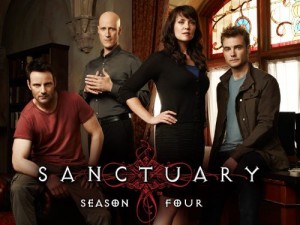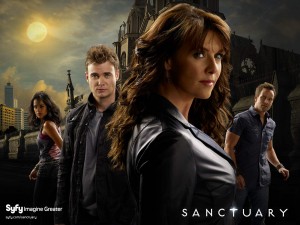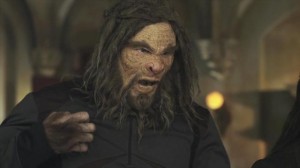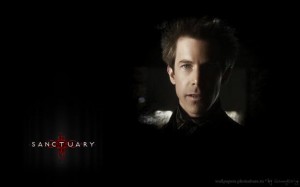
One of the big trends in the current television year has been the emergence of urban fantasy, once the preserve of geeks and anime addicts, into mainstream programming. Shows like Once Upon a Time and Grimm (which shall be reviewed in greater depth in an upcoming article on this blog) have threaded the fantastical, and the mythical into their story lines to great effect.
And yet while they are imaginative and wholly original in their own ways, I don’t think they are the true originators of the trend. That honour, I believe, belongs to Sanctuary, a show that debuted initially as a series of eight webisodes (web-based episodes) to great acclaim and success, prompting syfy to commission a 13 episode TV-based series of episodes.
Based on the premise that homo sapiens are not the only sentient species on the planet, just the dominant ones, the Sanctuary’s mandate is to protect those they call Abnormals, who are powerful, and in many cases intelligent, self-aware beings who have perfected the art of hiding in plain sight from an often fearful human population. While most of the Abnormals mean humanity no harm, some are aggressive and so in these instances, the Sanctuary steps in to contain them and hold them in a series of sanctuary outposts scattered throughout the world.

Headed by the mysterious but determined Dr Helen Magnus (Amanda Tapping of Stargate fame), who thanks to a serum containing pure vampire blood that she and four colleagues injected themselves with back in the nineteenth century, is effectively immortal, the Sanctuary pursues its mandate with rigour. She is aided in her noble cause by an initially reluctant police psychologist, Will Zimmerman (Robin Dunne), who becomes increasingly critical to and deeply invested in, the success of the sanctuary network. By the chatty Henry Foss (Ryan Robbins), the resident computer expert, who is both a geek and a Lycan (werewolf in other words, and himself an Abnormal).
And by Kate Freelander (Agam Darshi) who transforms from calculating loner working for the Sanctuary’s enemy the Cabal to a dedicated insider who values her new family far more than she values her old existence as a gun-for-hire. Rounding up one of the most engaging and idiosyncratic teams on television is “Biggie” or Bigfoot (Christopher Heyerdahl), also an Abormal. He has been with Magnus the longest and is committed to the cause on a deeply personal level since he has experienced much of the persecution and bigotry that comes from being an Abnormal.

Together this motley crew battle to protect vulnerable Abnormals, and in doing so, have to stand more often that between them and a human population that is either fearful of these creatures or seeking to exploit them.
It is an intriguing idea and the perfect platform to explore all manner of themes from being comfortable with who you are – a struggle for Henry when he discovers to his horror (at least to begin with) that is a Lycan – to the nature of what it truly means to be human. Along the way, there’s lots of swash buckling adventure, intrigue and explorations of a world that hides far more than it reveals.
That’s much like the characters themselves. All of them to some degree or another, intentionally or not, carry secrets, all of which eventually comes into play in one way or another. It’s the discovery of these secrets that makes watching the Sanctuary such an enjoyable experience.
But the greater joy lies in its generous helpings of myth and history and their melding into the enticing mythos of the show. For instance, one of Helen’s co-scientists, Nikola Tesla (Jonathan Young) is turned into a vampire by the same serum that indefinitely extended Helen’s life, and through him, vampires are portrayed as a tyrannical but incredibly advanced master race who ruled humanity till they rose up in revolt.

Or consider another of Helen’s colleagues, John Druitt (Christopher Heyerdahl again). He reacted to the serum by becoming a murderous skilled, possessed by an evil energy being that he struggles to keep in check. It is implied quite strongly that he is, in fact Jack the Ripper.
Finally a character that recurs for much of season 3, David Worth (Ian Tracey), a outsider to Helen Magnus’s high knit team of nineteenth century scientists, and a long running protagonist was said to be the inspiration for Jekyll and Hyde thanks to his violent mood swings.
It’s this synthesising of historical fact with fiction, and the mixing of religious belief with myth (such as the idea that the Hindu goddess Kali is a powerful super sized Abnormal) that makes it so compelling. Some people have accused the show of bastardising history but I think that misses the point. For a start it is escapist entertainment. Intelligent and well put together but escapist nonetheless. But for another, what underpins the show is a mix of the real and the imagined, and if nothing else, that is a trait common to all the shows now riding the wave of urban fantasy into our living rooms.